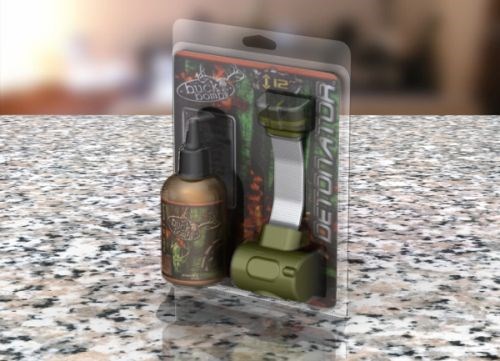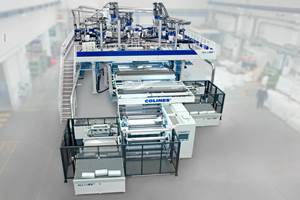Mid-Size Former Has Big-Time Tools
Dordan utilizes NX-generated photo realistic images and 3D package design movies to demonstrate how package has been designed for manufacturing, including part functionality and shelf impact.

With renderings like this furnished by Dordan, the Buck Bomb team was able to see what their product(s) would look like packaged in a clamshell family without having to spend a penny in prototype tooling.
We’ve featured Dordan Manufacturing Co., Woodstock, Ill., twice recently in Plastics Technology, in May 2011 and March 2013, mostly highlighting the thermoformer's unwavering efforts to include PET clamshells in the post-consumer recycling stream. But as successful as this family-owned, 50-year custom former has been to improve the environmental footprint of its operation, it’s been equally adept at using high-end tools to support its core business: clamshell package design for a wide range of industries.
Some of these tools are more commonly found at an automotive OEM than a custom thermoformer, but Dordan has successfully deployed them in packaging too. States Chandler Slavin, the company’s marketing manager/sustainability coordinator: “If you subscribe to the ideology that packaging has the ability to help or hinder product sales, it is paramount to see what the package will look like on the shelf. Often times, an engineering drawing doesn’t communicate shelf impact. And cutting prototypes is considered too costly in the early phases of the packaging procurement process.”
As a result, Dordan has found it important to develop a stepping-stone between concept and reality when it came to communicating a packaging concept’s form and function to the customer.
Dordan used to subscribe to I-DEAS (Integrated Design and Engineering Analysis Software), a product originally furnished by Structural Dynamic Research Corp. (SDRC) that allowed it designers to create engineering drawings and wire frames, Ms. Slavin says. The former would also use this tool to generate ray-traced images. “Ray-traced images were helpful in that they communicated the overall shelf impact of the part, but they took up to a week to generate—completely consuming the output of the computer— and were not that visual accurate because the plastic did not look ‘see-through’ like plastic should,” states Ms. Slavin.
Electronic Data Systems (EDS) bought SDRC about 12 years ago, and combined it with Unigraphics (acquired when EDS bought UGS Corp.) to create NX, an advanced high-end CAD/CAM/CAE software package now owned by Siemens PLM Software. “Once that happened Dordan began experimenting with the 3D modeling and photo-realistic rendering options that NX offered, laying the foundation for what we call our Design for Thermoforming Process,” Chandler Slavin says.
Dordan’s experience in designing a new package for The Buck Bomb shows how her company’s Design for Thermoforming Process saves time and money while reducing risk and expediting decision-making.
The Buck Bomb is a scent-dispersal product used by hunters. It consists of a detonator and the spray scent. The Buck Bomb used to be sold in blister packs, but the company was interested in what it would look like if packaged in a clamshell. Consequently, it approached Dordan—its current blister supplier—communicating its request.
But there was a catch: The way The Buck Bomb was sold at retail changed depending on the retail outlet; sometimes just the spray scent was sold, other times just the detonator, and yet others wanted the detonator and spray scent sold together. In other words, The Buck Bomb needed a family of clamshell packages, and they needed them for a price that was competitive with their existing blister packaging. “How do you show a customer what the various formulations of their product/packaging scenarios will look in clamshells like if the customer is not willing to invest in prototype tooling and an engineer drawing/wire frame isn’t sufficient?” Ms. Slavin says.
“Dordan’s Design for Thermoforming Process incorporates the process of manufacturing into the packaging developmental phase; it assumes the artistic capabilities inherent in the art of thermoforming for every project, allowing for the seamless transition from concept to reality,” she states.
This process utilizes NX-generated photo realistic images and 3D package design movies to demonstrate how the package has been designed for manufacturing, including part functionality and shelf impact. Unlike the ray-traced images of I-DEAS, these renderings can be created quickly, and the resulting imagery extremely accurate.
Says Ms. Slavin: “With these renderings, the Buck Bomb team was able to see what their product(s) would look like packaged in a clamshell family without having to spend a penny in prototype tooling. By seeing a fully-engineered digitally produced ‘photo’ of the proposed packaging, The Buck Bomb team was able to expedite the decision making process as marketing understood how it's priorities were met via photo renderings while engineering understood how it’s priorities were met via engineer drawing. Moreover, in producing photo-realistic renderings/3D videos prior to moving to prototype, the risk of any potential design flaws in the prototype part is mitigated by the front-end engineering that is required to produce these images.”
As a result of this effort, Dordan developed a family of clamshells that maintained The Buck Bomb brand aesthetic while reducing the overall SKUs, saving time and money.
Related Content
‘Monomaterial’ Trend in Packaging and Beyond Will Only Thrive
In terms of sustainability measures, monomaterial structures are already making good headway and will evolve even further.
Read MoreUS Merchants Makes its Mark in Injection Molding
In less than a decade in injection molding, US Merchants has acquired hundreds of machines spread across facilities in California, Texas, Virginia and Arizona, with even more growth coming.
Read MoreYoung Stretch-Film Processor Bets on Nanolayers
Going up against companies with as much as double its capacity, young stretch-film processor Zummit believes that new technology — notably 59-nanolayer films — will give it a competitive edge.
Read MoreHow to Optimize Injection Molding of PHA and PHA/PLA Blends
Here are processing guidelines aimed at both getting the PHA resin into the process without degrading it, and reducing residence time at melt temperatures.
Read MoreRead Next
Processor Turns to AI to Help Keep Machines Humming
At captive processor McConkey, a new generation of artificial intelligence models, highlighted by ChatGPT, is helping it wade through the shortage of skilled labor and keep its production lines churning out good parts.
Read MoreHow Polymer Melts in Single-Screw Extruders
Understanding how polymer melts in a single-screw extruder could help you optimize your screw design to eliminate defect-causing solid polymer fragments.
Read MoreTroubleshooting Screw and Barrel Wear in Extrusion
Extruder screws and barrels will wear over time. If you are seeing a reduction in specific rate and higher discharge temperatures, wear is the likely culprit.
Read More


























